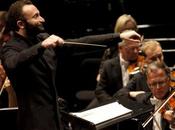Eccoci al consueto appuntamento mensile con le nostre analisi comparate di interpretazione liederistica. Questa volta la mia scelta è caduta su una delle composizioni vocali di Richard Strauss da me predilette. Si tratta di “Ständchen”, secondo brano della raccolta Sechs Lieder von Adolf Friedrich Graf von Schack, composta nel 1887.
Qualche cenno biografico sull’ autore del testo. Adolf Friedrich von Schack (1815 – 1894), nativo di Schwering nel Mecklenburg-Vorpommern, fu poeta, critico letterario e storico dell’ arte. Dopo avere studiato Giurisprudenza a Bonn, Heidelberg e Berlino e aver inizialmente lavorato presso la Kemmergericht della capitale prussiana, compì numerosi viaggi attraverso l’ Europa. Nel 1855 si stabilì a München, dove venne nominato Ehrenmitglied dell’ Akademie der Wissenschaften. La sua ricca collezione di dipinti, comprendente soprattutto opere di Moritz von Schwind, Anselm Feuerbach, Franz von Lenbach, Arnold Böcklin e Carl Spitzweg, venne da lui lasciata in eredità al Kaiser Wilhelm II, a condizione che rimanesse a Monaco. L’imperatore decise di far costruire un edificio per ospitare la vasta collezione. Il lascito venne ospitato nel palazzo appositamente realizzato Max Littmann, la Schackgalerie in Prinzregentenstraße 9. ultimato nel 1910.
Le poesie di Adolf von Schack non sono annoverate tra i massimi capolavori della letteratura tedesca, anche se non mancano di eleganza e capacità evocative. Richard Strauss comunque le prediligeva, visto che ne mise in musica sedici in tutto. La musica di “Ständchen” è splendida per qualità di ispirazione melodica e sapienza di costruzione formale, pur nella classica semplicità dello schema armonico.
Ecco il testo poetico.
Ständchen
Mach auf, mach auf, doch leise, mein Kind,
Um keinen vom Schlummer zu wecken.
Kaum murmelt der Bach, kaum zittert im Wind
Ein Blatt an den Büschen und Hecken.
Drum leise, mein Mädchen, daß nichts sich regt,
Nur leise die Hand auf die Klinke gelegt.
Mit Tritten, wie Tritte der Elfen so sacht,
Um über die Blumen zu hüpfen,
Flieg leicht hinaus in die Mondscheinnacht,
Zu mir in den Garten zu schlüpfen.
Rings schlummern die Blüten am rieselnden Bach
Und duften im Schlaf, nur die Liebe ist wach.
Sitz nieder, hier dämmert’s geheimnisvoll
Unter den Lindenbäumen,
Die Nachtigall uns zu Häupten soll
Von unseren Küssen träumen,
Und die Rose, wenn am Morgen erwacht,
Hoch glühn von den Wonnenschauern der Nacht.
E questa è la traduzione italiana di Andrea Casalegno
Serenata
Apri, apri, ma piano, bambina,
per non destare nessuno dal sonno.
Il ruscello mormora appena, trema appena nel vento
una foglia del cespuglio o della siepe.
Piano perciò fanciulla, ché nulla si muova,
accarezza la maniglia appena appena.
A passi delicati, come quelli degli elfi
quando saltellano di fiore in fiore,
vola fuori leggera, nella notte di luna,
scivola fino a me nel giardino.
Dormono i fiori attorno, lungo il torrente che goccia,
e profumano nel sonno; solo amore veglia.
Siediti; qui, sotto i tigli,
c’ è un’ ombra piena di mistero;
l’ usignolo vicino al nostro capo
sognerà i nostri baci, e la rosa,
destandosi al mattino, avvamperà
dei voluttuosi brividi notturni.
Ed ecco, secondo lo schema abituale di questa rubrica, i consueti contributi musicologici. Il primo è questo saggio, dettagliato ed esaustivo, di Alyssa Brode, Bachelor of Music in Voice al Westminster Choir College, scrittrice e freelance graphic designer.
Richard Strauss’ setting of Friedrich von Schack’s Ständchen proves his finesse at his craft while all the while highlighting that which gave him his renown. Known largely for his gorgeous vocal lines (often crafted for the soprano voice) and a combination of classical elegance and post-Wagnerian experimentation (due to his admiration for both Wagner himself and Mozart), Strauss leaned more towards his classical side in the ever-popular Ständchen.
Friedrich von Schack’ s poem consists of three stanzas, each with six lines alternatively containing four and three feet to the line (except the last line of each stanza which repeats its predecessor’ s length of four feet). Each stanza’s rhyme scheme is ABABCC. The poetry is serene, spoken by a man to his soon-to-be-sleeping beloved. He describes to her a fantasy world of tranquility and soothing imagery: elves with footsteps light enough to hop among flowers, a moonlit night in the garden. The words themselves are soothing and soft, engaging the reader in the serene atmosphere. It seems as though the speaker was prompted to describe such a delicate setting at the image of his lover falling asleep, to lull her into sweet dreams; there is very straightforward, loving intention here. Though this is truly setting a scene rather than telling a story, there is a sense of passage of time; from describing the moonlight, the narrator proceeds to reference waking in the morning.
This three-stanza structure is transferred directly by Strauss into three verses. The first two verses are treated strophically. Meanwhile, the third begins with entirely new material-a much more declamatory vocal line than prior to that moment, a key change-before returning to familiar territory again. The text is generally retained otherwise, despite the line “Die über die Blumen hüpfen” in which Strauss both changed a word (“die” to “um”) and added a word (a penultimate “zu,” perhaps to better implement good declamation) as well as the phrase “Hoch glühn” (glowing on high) to reiterate the beauty, perhaps, in the last image. This text is clearly set, unobstructed by ornamentations or range.
Just as von Schack set a scene throughout the soft yet vibrant descriptions in the poetry, Strauss sets the scene in his musical setting. Though his commitment to a beautiful vocal line above all else is not untrue here-and Ständchen proves his success in doing so-he also incorporates the text quite seamlessly to help illustrate that which von Schack has created. The piece begins with an immediate gesture of an upwards octave leap; the text simultaneously proclaims “open up!” The sweeping, arpeggiating accompaniment transmits us to a mystical dream world while also illustrating the brook to which von Schack makes several poetic references.
As stated previously, Strauss does not neglect his love for beautiful melodic lines in any way in this piece. Tuneful and sweeping, the vocal phrases are long and operatic in scope. Beginning with an octave of an interval, the piece goes on to demand a range of a major 11th from its singer and doesn’t really “rest” in any one part of the range. However, the place at which this melody is forsaken-measure 48 begins a more declamatory passage-is for the sake of text. Its key shift downwards while the text proclaims, “Sit down!” In this passage, more conscious of waking and the threat of morning ruining that paradise which has been so carefully created, the vocal line becomes less celebratory and more like speech in the awareness of reality. At the same time, the mysteriousness of this world is being described which can also partially account for the shifting nature of the melodic arc.
Also as noted before, the predominant piano figure in this homophonic work is the arpeggiating accompaniment (with no vocal line present within it). Notable about this is its characteristic qualities of Strauss’ songwriting. As this work is heavily focused on the vocal line, the accompaniment plays the role of harmonic support, something Strauss tended heavily towards in his solo writing. Meanwhile, besides its text painting characteristics already depicted, its rapid figuration is reminiscent of a stringed instrument: evocative, perhaps, of an orchestral setting (of which there is one for this same piece). Strauss, no stranger to larger works, would likely have sought to do this intentionally.
What is unusual about this piece for Strauss, though, is the simplicity of harmony. Though often teetering on the edge of chromatic experimentation in the style of Wagner and other experimental post-romantics, Strauss here chooses to incorporate very straightforward and functional harmonies, nearly all of which are diatonic. The only real chromatic flavor he includes is at the beginning of the third verse, adding to the temporarily shifting nature of the poetic intent already discussed; almost immediately afterwards, he returns to diatonicism and the serenity of before. (The chromaticism in the vocal line is synced with this event.)
While this piece is characteristically “Strauss” in its melodic structure, its operatic nature and its submissive yet orchestrally conceived accompaniment, his harmonic choices in it were not what many typically associate with Strauss’ vocal writing. With somewhat of a lack of chromatic experimentation, Ständchen is certainly one of Strauss’ more conservative pieces, harmonically speaking; it reveals much more about his influence of Mozart than of his very strong love of Wagner. However, its tendency towards his less experimental side with chromatic harmony has not prevented it from becoming one of his most beloved songs.
Molto interessante e puntuale è anche questa analisi del pianista e musicologo sudafricano Albert Combrink.
Early in his career Strauss was obviously taken with the poems of Von Schack – the son of a wealthy landowner – setting 16 of his poems in the songs which comprise his Opus 15, 17 and 19 sets, completed by the age of 24. As with most of Strauss’ choice of poets, Schack might not be regarded as a towering figure in the poetic landscape, so to speak. Yet his poems provide much suggestive imagery to stimulate the imagination – especially one as creative as Strauss. Schack’ s moonlit forest shakes, trembles, quakes and quivers and in the morning the roses will be glowing form the night’s “Wonnenschauern” – a virtually untranslatable portmanteau suggesting the “joyous showers” of the night’s activities (perhaps one would be wise not to interpret it only literally). The grammar of the poem makes it hard to distinguish whether the poet is taking the beloved into the night, or merely singing a song of seduction and describing the delights that await them – as the title suggests. The music however, tells a fuller story.
Tonality is vitally important in the music of Strauss and he adhered loosely to a set of tonal symbols. C major is often regarded as his “Key of Creation”, of elemental power, the source of the Big Bang: note for example the opening of Also Sprach Zarathustra or the song Zueignung (Op. 10 No.1) – both powerful existential statements. A flat major is used for pious religious expressions such as those of John the Baptist in the opera Salome. Ständchen is in F Sharp major, a key it only shares with a single other song from his 205: Traum durch die Dämmerung. This is also the key of love at first sight in the “Presentation of the Rose” duet from Der Rosenkavalier. Often associated with love, dreaminess and intoxication, this key suggests two lovers “high” on love, the romance of the moment and the beauty of the surroundings.
Musically the first two verses are repeated verbatim. Verse one lures the beloved out the door. Verse two lures the beloved into the darkness of the Linden trees. Octave leaps, like an ardent but secret call and long passages in the same key suggest so beautifully the furtive seduction. The piano quakes and quivers in excitement and but also surrounds the voice in the night-sounds of the forest: the trembling, rustling and positively quaking leaves and the murmuring trickle of the ever-flowing but never dangerous stream. The excited frisson in the hearts of the lovers is expressed in the darting of the piano part. The figuration is more pianistic than it appears at first sight: The 4th finger falls naturally on the black notes and the short 5th finger feels comfortably in place on the adjacent white finger, making the rippling pianissimo a joy to play. Yet some sharp-shooters’ aim is required when the modulations move in between the black notes.
Verse three gets down to the serious business of love-making. As the beloved is invited to “sink down” on the soft grass, the piano part sinks gently down to the key of D Major, the key of nature: Daphne in the garden; the garden of the “Vier Letzte Lieder. The flattened VI key is such a quintessentially Romantic musical symbol for the mysterious and the magical. Another magical use of the flattened sixth key occurs in Schubert’s rapturous Nacht und Träume (Night and Dreams, D. 827) of 1822, where the joy of the dreamers is expressed with breathtaking tenderness.
The piano part of the third verse reveals some fussiness on the part of the composer. The little figurations, while remaining true to the original idea, change shape and inversions a few too many times, making it unnecessarily awkward for the pianist. I wonder if some have not cheated the odd beat or two. It is mainly pianissimo and the pedal hides a multitude of sins. As the piano part modulates downwards to B Major, the voice starts its ecstatic ascent to the climax, Strauss finding it necessary to repeat the words “Hoch glühn” (glowing on high) to sustain the excitement and extend the exquisite consummation.
At this point there is a discrepancy between the piano-accompanied version of the song, and the orchestral arrangement of the song. In the orchestral version the high A sharp of the climax is held double the length. It is a glorious effect. I have heard various sopranos take the “long cut” in the piano version, with the pianist either left high and dry at the barline, or, in the case of some conductor-pianists such as Wolfgang Swallisch and Sir Georg Solti, they reversed the process of orchestration and rewrote the piano part, adding extra bars as per the orchestral version. The orchestral version also ends more abruptly, leaving out the piano’s brief but charming postlude.
Strauss only wrote 15 of his 205 songs expressly for Voice and Orchestra. He himself orchestrated 25 of the piano accompaniments and sanctioned some by others. These orchestrations were done at various times in his career, often to provide concert material for his wife Pauline de Ahna and some of the various sopranos with whom he travelled after Pauline’s career started winding down, such as the creator of the title role in Arabella, Viorica Ursuleac whom Strauss called “die treueste aller Treuen” (“the most faithful of all the faithful”).
Veniamo ora alle versioni prescelte per il confronto, iniziando da quella di Heinrich Schlusnus (1888 – 1952) qui accompagnato dal pianista Otto Braun.
Ho già più volte espresso in questi post la mia grande ammirazione per l’ arte vocale del baritono di Braubach, che anche in questo caso impartisce un’ autentica lezione di fraseggio, consapevolezza stilistica e capacità di piegare ad infinite sottigliezze dinamiche una voce scura e densa.
Il secondo ascolto proposto è invece più inusuale. Si tratta infatti di Jussi Björling, uno dei massimi tenori del Novecento, qui ripreso in una trasmissione televisiva del 19 novembre 1951.
Una prestazione di grandissimo rilievo, senza discussioni. Il fraseggio è notevole per eleganza e padronanza linguistica e la bellezza dello strumento, che il tenore svedese domina alla perfezione grazie a una tecnica di grande scuola, consente di mettere in rilievo la linea melodica tramite combinazioni coloristiche davvero affascinanti.
Ancora un nome nuovo per il prossimo ascolto. Si tratta di Rudolf Schock (1915 – 1986) che esegue il brano nella versione orchestrale, con i Berliner Symphoniker diretti da Wilhelm Schüchter, in una registrazione radiofonica del dicembre 1957.
Nativo di Duisburg, Rufolf Schock fu uno dei divi più popolari del mondo musicale tedesco, grazie a una versatilità che gli consentiva di esprimersi ad altissimi livelli nel repertorio operistico, nell’ operetta, di cui fu uno degli interpreti più acclamati, nella liederistica e nella canzone. Il suo nome divenne popolare anche grazie a una serie di fortunatissimi film, che realizzarono incassi da record nei paesi di lingua tedesca e ancora oggi sono regolarmente trasmessi dalle tv in Germania e Austria. La sua versione è assolutamente esemplare per l’ eleganza, la dizione scolpita e rifinitissima e il fraseggio, intenso e concentrato.
Anneliese Rothenberger (1926 – 2010) fu una delle partner preferite del tenore renano, insieme al quale formò quella che per anni venne considerata la coppia regina dell’ operetta sui palcoscenici tedeschi e austriaci. Come Schock, la cantante di Mannheim fu un personaggio che godette di una popolarità estesa ben oltre i confini del pubblico operistico, grazie anche ad un’ intensa attività televisiva, con programmi di grande successo come Anneliese Rothenberger gibt sich die Ehre, trasmesso in prima serata al sabato sera sulla ZDF. Ecco il Lied nella versione della Rothenberger, incisa durante un concerto a Mosca, con il pianista Günther Weissenborn.
Sono da sempre un grande ammiratore della grande cantante di Mannheim, che come liederista dimostra, anche in questa occasione, qualità di fraseggio da vera fuoriclasse e una perfetta immedesimazione espressiva, con un gusto davvero infallibile.
Ma ad un livello ancora superiore si colloca l’ interpretazione di Julius Patzak (1898 – 1974) in questa versione incisa nel 1944, con la Symphonieorchester des Bayerischen Rundfunks diretta da Richard Strauss in persona.
Qui c’ è davvero poco da aggiungere, siamo a un livello di assoluto riferimento per la perfezione della linea vocale e la bellezza dell’ atmosfera espressiva, grazie anche alla direzione assolutamente idiomatica dell’ autore, che come sappiamo era direttore d’ orchestra di livello indiscutibile.
Chiudiamo qui, dandovi appuntamento alle prossime puntate.







